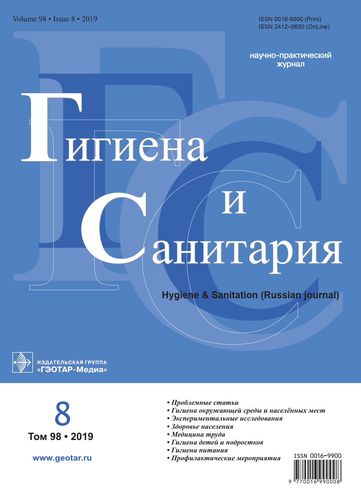The selection of the respirators as a result of studies of their workplace protection factors (review)
- Авторлар: Kaptsov V.A.1, Chirkin A.V.2
-
Мекемелер:
- All-Russian Research Institute of Railway Hygiene of the Federal Service for the Oversight of Consumer Protection and Welfare
- LTD “BETA-PRO”
- Шығарылым: Том 98, № 8 (2019)
- Беттер: 845-850
- Бөлім: OCCUPATIONAL HEALTH
- ##submission.datePublished##: 15.08.2019
- URL: https://stomuniver.ru/0016-9900/article/view/639664
- DOI: https://doi.org/10.47470/0016-9900-2019-98-8-845-850
- ID: 639664
Дәйексөз келтіру
Толық мәтін
Аннотация
Currently, respiratory protective devices (RPD) play an important role in the system of the workers’ protection from the polluted atmosphere in the Russian Federation. The article describes the history of evaluation of workplace protection factors (WPFs) in USA and UK, and their impact on the law requirements for the employers (in developed countries), that determine the selection of RPD for known workplaces’ conditions. WPFs measurements revealed a low efficiency of the four types of RPD compared to measurements in laboratories. This difference prompted a change in the requirements for employers. The Assigned Protection Factors of three types of Powered Air Purifying Respirators (PAPRs) were reduced: for PAPRs with a full facepiece - from 2000 to 40; for PAPRs with hood or helmet - from 1000 to 25; for PAPRs with half mask - from 500 to 50. The Assigned Protection Factor of gas masks was reduced from 900 to 40. Western requirements for selecting RPD are compared with the practice and recommendations for choosing RPD in the RF. There were revealed significant differences increasing the risk of acute poisoning and the development of chronic diseases among workers. Specific recommendations are given to reduce these risks: reduction of air pollution in the workplaces; development of requirements for the selection of RPD in the RF, based on the best Western requirements; participation of the industrial hygienists in the development of requirements for RPD and training materials for the specialists and workers; development and implementation of the Biological Exposure Indices.
Негізгі сөздер
Авторлар туралы
Valery Kaptsov
All-Russian Research Institute of Railway Hygiene of the Federal Service for the Oversight of Consumer Protection and Welfare
Хат алмасуға жауапты Автор.
Email: kaptsovva39@mail.ru
ORCID iD: 0000-0002-3130-2592
MD, Ph.D., DSci., Professor, Corresponding Member of the Russian Academy of Sciences, Head of the Department of Occupational Health of the All-Russian Research Institute of Railway Hygiene of the Federal Service for the Oversight of Consumer Protection and Welfare, Moscow, 125438, Russian Federation.
e-mail: kaptsovva39@mail.ru
РесейA. Chirkin
LTD “BETA-PRO”
Email: alexandr.chir@yandex.ru
ORCID iD: 0000-0003-3661-8323
Ресей
Әдебиет тізімі
- Izmerov N.F. Kirillov V.F., eds. Occupational hygiene [Gigiena truda]. Moscow: GEOTAR-Media; 2008. (in Russian)
- Koshelev V.E., Tarasov V.I. Problems in protecting workers with gas masks [Prosto o neprostom v primenenii sredstv zashchity dyhaniya]. Perm’: Agentstvo «Stil’-MG»; 2007. (in Russian)
- Held B., Kotowski M. Respiratory Protection. In: Cralley L.V. ed. Patty’s Industrial Hygiene and Toxicology (2 ed), V. 3A. NY: Willey-Interscience; 1985.
- S. van der Gijp, L. Steenweg. Respirator Performance during Military Field Trials. J Int Soc Respir Prot. 2004; 21 (3–4): 135–41.
- Kirillov V.A., Filin A.S., Chirkin A.V. Overview of industrial testing outcome of respiratory organs personal protection equipment. Toksikologicheskij vestnik [Toxicological Review]. 2014; 6: 44–9. (in Russian)
- Nelson T.J. The Assigned Protection Factor According to ANSI. Am Ind Hyg Ass J. 1996; 57 (8): 735–40. https://doi.org/10.1080/15428119691014594
- Myers W.R., Peach M.J., Cutright K., Iskander W. Workplace Protection Factor Measurements on Powered Air-Purifying Respirators at a Secondary Lead Smelter: Results and Discussion. Am Ind Hyg Ass J. 1984; 45 (10): 681–8. https://doi.org/10.1080/15298668491400449
- Myers W.R., Peach M.J., Cutright K., Iskander W. Field Test of Powered Air-Purifying Respirators at a Battery Manufacturing Facility. J Int Soc Respir Prot. 1986; 4 (1): 62–89.
- Lenhart S.W. & Campbell D.L. Assigned Protection Factors for two respirator types based upon workplace performance testing. Ann Occup Hyg. 1984; 28 (2): 173–82. https://doi.org/10.1093/annhyg/28.2.173.
- Myers W.R., Peach M.J. III. Performance measurements on a powered air-purifying respirator made during actual field use in a silica bagging operation. Ann Occup Hyg. 1983; 27 (3): 251–9. doi: 10.1093/annhyg/27.3.251
- Tannahil S.N., Willey R.J., Jackson M.H. Workplace protection factors of HSE approved negative pressure full-facepiece dust respirators during asbestos stripping: Preliminary findings. Ann Occup Hyg. 1990; 34 (6): 547–52. https://doi.org/10.1093/annhyg/34.6.547
- British Standard BS 4275:1997 «Guide to implementing an effective respiratory protective device programme», 2 ed. London: BSI; 1997.
- Howie R.M., Johnstone J.B.G., Weston P., Aitken R.J., Groat S. Workplace effectiveness of respiratory protective equipment for asbestos removal work. Edinburgh: Institute of Occupational Medicine; 1996.
- Hyatt E.C. Respirators: How Well Do They Really Protect? J Int Soc Respir Prot. 1984; 2 (1): 6–19.
- OSHA Standard 29 CFR 1910.134 «Respiratory Protection».
- Sklyarov F.I. New respirator with helmet for sandblasters. Occupational Health and Safety [Gigiena truda i tekhnika bezopasnosti]. 1937; 2: 74–6.
- Kaptsov V.A., Chirkin A.V. About efficiency of individual protection equipment of respiratory organs as prophylactics of diseases (review). Toxicological Review [Toksikologicheskij vestnik]. 2018; 2: 2–6. (in Russian)
- Bollinger N., ed. NIOSH Respirator Selection Logic. Cincinnati, Ohio: NIOSH; 2005. https://doi.org/10.26616/NIOSHPUB2005100
- Kirillov V.A., Chirkin A.V. On individual protective means for workers’ respiratory organs (review of literature). Occupational Medicine and Industrial Ecology [Medicina truda i promyshlennaya ehkologiya]. 2013; 4: 25–31. (in Russian)
- Vilk M.F. On improving the registration of professional morbidity in railway workers. Gigiyena i sanitariya [Hygiene and Sanitation, Russian journal]. 2001; 6: 37–40. (in Russian)
Қосымша файлдар







